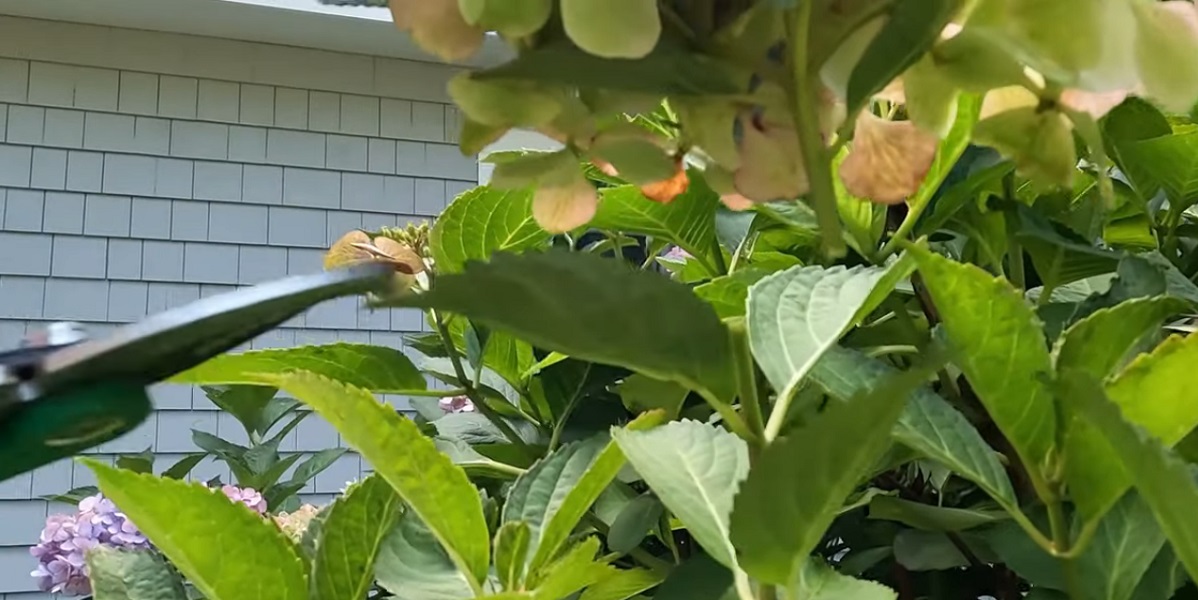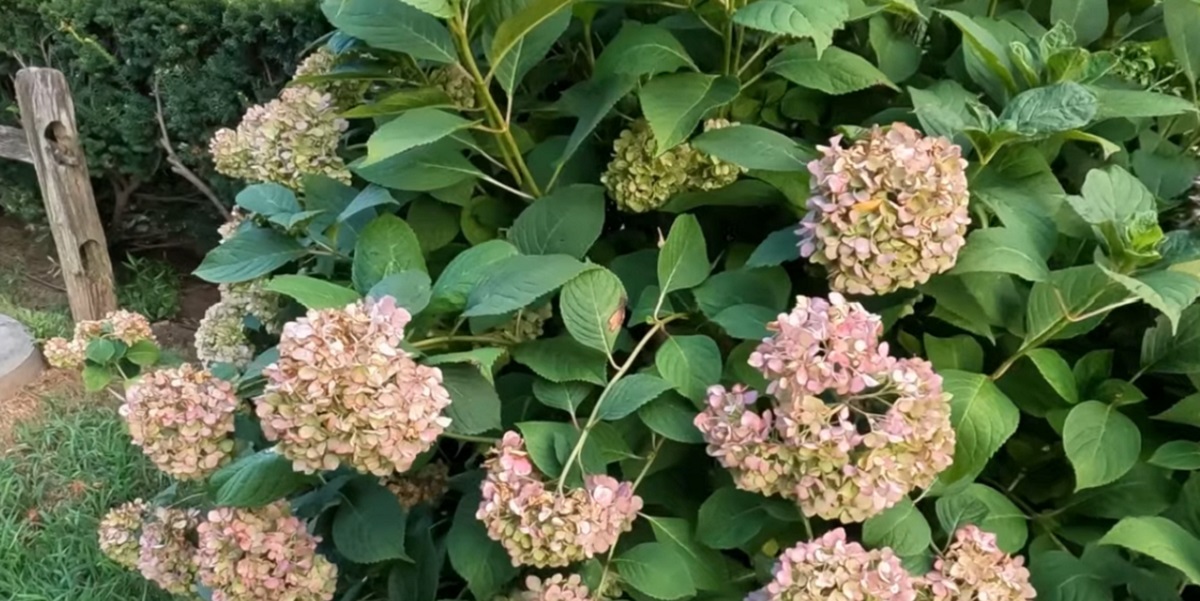how to look after hydrangeas in the garden for all seasons?
DESCRIPTION OF ANNABELLE HYDRANGEA VARIETIES
Hydrangea Anabel is a garden ornamental plant that looks beautiful in landscaping.
The shrub can decorate any area and is very low maintenance, although it requires some effort.
The shrub has a dome shape. The height of Annabelle hydrangea is tree-like and up to 1.5 m, the width of the shrub reaches 2-3 m in diameter.
The leaves of the plant are oval, up to 20 cm long, with a pointed tip and rough edges.
The leaf plates grow very densely, and the dark green color remains almost until winter – this is one of the main advantages of the variety.
Annabelle is appreciated for its beautiful flowering. In midsummer, in July, it forms small flowers, which are in large spherical inflorescences up to 25 cm in diameter.
At the beginning of flowering, the inflorescences are bright green, but then turn bright white and remain so until autumn.
Important There is also a subspecies of pink Annabelle hydrangea. The bushes are almost similar to each other, the only difference is the shade of flowers – in Annabelle they are pink.
Annabel ball hydrangea can become a perennial in the garden, its life cycle lasts about 45 years. This plant grows rapidly, the annual growth can be up to 20 cm.
ANNABELLE IS A HYDRANGEA-LIKE TREE IN LANDSCAPE DESIGN
Gardeners love Annabelle because this shrub looks attractive in almost any landscape. A plant is used sparingly, but very wide and dense:
- – to create individual compounds;
- – as an element of group plantings;
- – in the form of an unusual hedge;
- – to decorate empty corners of the garden, for example, near walls and fences.
Annabelle’s hydrangea blooms until late autumn, producing beautiful, brilliant white flowers.
It continues to decorate the garden even after all other plants have finished blooming and fly around before the onset of winter.
Hydrangea looks attractive against the background of conifers, large white inflorescences accentuate the deep and rich green of the conifers.
how to look after hydrangeas in the garden for all seasons?
ANNABELLE HYDRANGEA WINTER HARDINESS
Tree hydrangea has a very high resistance to cold. This plant can withstand temperatures of -40 degrees Celsius, which is why Annabel’s tree hydrangea is often found in Siberia.
However, young hydrangeas can tolerate temperatures as low as -20 degrees Celsius. Stronger frosts are dangerous for them.
PLANTING AND CARING FOR ANNABEL’S HYDRANGEA TREE
The hardy shrub does not have very demanding care requirements. But it is necessary to familiarize yourself with the rules of growing the variety to provide comfortable conditions for Annabelle.
SELECTION AND PREPARATION OF THE LANDING SITE
It is best to plant Annabelle as a tree in the spring so that the plant has time to acclimatize before the onset of winter cold.
The location for the hydrangea is sunny but slightly shaded – Annabelle loves the light but does not tolerate full sun.
You can plant a shrub under the shelter of a house wall or next to tall trees.
However, be careful not to deprive the hydrangea of moisture, otherwise, the plant will always suffer from a lack of nutrients.
In the place chosen for the hydrangea, dig a planting pit – about 50 cm deep and 40 cm wide. Since Annabelle prefers fertile soil, humus and peat are added to the excavated soil in equal proportions.
Also, sand should be added to the soil mixture, it loosens the soil and provides good drainage.
Hydrangeas love moisture, but boggy soil is bad for them. Therefore, when planting, you need to make sure that the drainage water does not penetrate deeper than 1.5 meters below the soil surface.
Planting annabelle hydrangea
Immediately before planting, we immerse the seedling in water with potassium permanganate solution for a short time.
This saturates the roots with moisture and at the same time disinfects them.
The landing algorithm is as follows:
- The growing hole is half-filled with prepared nutrient soil, forming a small mound.
- The Annabelle seedling is sunk into the prepared pit and the roots of the plant are aligned so that they lie evenly against the sides of the mound.
- The remaining soil is poured into the hole, filling it to the bottom – the root neck of Annabelle should be slightly above the ground.
- The soil is lightly tamped down so that it does not sag, and the young plant is abundantly watered.
Immediately after that, the circle of the trunk is mulched in a dense layer, otherwise, the moisture will evaporate very quickly.
As a rule, several shrubs are planted on the plot to create a decorative composition.
The distance between each plant should be at least 2 meters, the gardener should take into account that the bush grows strongly in width.
Note When preparing the planting pit and during planting should not be added to the soil lime or wood ash, as they make the soil alkaline, which is very harmful to the plant.
IRRIGATION AND TOP DRESSING
Annabelle tree hydrangea loves moisture, yet is a drought-tolerant plant. In the hot summer, it can patiently wait for watering without falling over and dying from lack of moisture.
However, it is recommended to water the shrub regularly to keep the hydrangea evergreen and beautiful.
Watering depends on the weather conditions. With the onset of spring and after the snow melts, you need to make sure that the soil in the circle around the boot does not dry out.
It is recommended to keep the soil slightly moist for Annabelle, and it is especially important to carefully control the moisture content during the flowering period. During this period, the plant needs the most nutrients.
For young plants, it is recommended to water more during the active growth period.
Hydrangeas form branches and green masses, and sufficient water stimulates them to grow well.
Fertilizers are not necessary. But if you want to grow a rampant, lush flowering plant in the garden
Nutrition plan:
- The first top dressing is traditionally done in early spring before the growing season begins. This involves adding complex minerals to the soil – phosphorus, potassium, and nitrogen. The second element is especially important for hydrangeas in the spring because it stimulates the growth of branches and leaves.
- The second time the bush is fed just before the opening of buds. At this time, the soil should be added phosphorus and potassium, which will increase the endurance of the plant and ensure a long and beautiful flowering.
- In the summer you need to feed Annabel once a month, you can use nitrous, diluted fertilizers, or chicken manure, as well as complex minerals. Fertilizers help prolong flowering and maintain the beauty of the plant until autumn.
In addition, in the summer it is recommended to treat Annabelle with a solution of potassium permanganate, this agent prevents infection of the bush with fungal diseases.
Fertilization of hydrangeas is also carried out in the fall. At this time it is better to fertilize the bush with potassium and phosphorus, as well as organic material – peat and humus. Nitrogen, on the contrary, can not be applied in the fall, it stimulates growth processes that the plant does not even need before winter.
prune annabelle hydrangea
In landscaping, it is common to prune hydrangeas regularly. Without pruning Annabelle grows too untidy and loses the precision of the silhouette.
This procedure is carried out in the spring, before the beginning of active vegetation – hydrangea branches are shortened by about 15 cm or one-third, giving them a beautiful dome shape.
Pruning is necessary not only to maintain the silhouette but also to ensure abundant flowering. If Annabelle grows too much, its flowers will gradually become smaller and less abundant.
Important Pruning of Annabelle hydrangea can be done only from the fourth year of life. Young shrubs can not be pruned.
In the fall, you can additionally perform sanitary pruning. This involves cutting off all dry and broken branches of the shrub. After pruning in the fall, Annabelle hydrangea better survive the winter and begin active growth in the spring.
A SHELTER FOR WINTER HYDRANGEA ANNABELLE
A shrub like a mature tree can tolerate very low temperatures. However, a young plant may suffer from frosts below -20°C. Therefore, it is recommended to cover the Annabelle hydrangea in the Urals and other cold regions in the first years with the onset of winter.
At the end of autumn, just before the cold, the shrub is cleared of dried stems and foliage remains, and the soil in a circle around the trunk is mulched with sawdust, organic fertilizer, or needles.
The branches of the plant can be bent to the ground and fixed so that Annabelle does not break under the weight of the snow. If the Annabelle hydrangea winter is very cold, you can cover the bush with fleece or spruce branches.
PROPAGATION OF ANNABELLE HYDRANGEA
The shrub looks so attractive at the site that many gardeners sooner or later tend to increase the number of plantings.
To do this, it is not necessary to buy a seedling, because the hydrangea is propagated completely vegetatively in the presence of a healthy adult shrub:
1. cuttings _ At the very beginning of spring, the heads of the young branches of the shrub are cut about 15 cm and placed in water for 2 weeks to sprout.
Once the cuttings are rooted, they can be planted in small containers with normal hydrangea soil and grown indoors at about 2 °C for another 22 years.
When the shoots have developed into proper healthy seedlings, they can be transplanted to an outdoor location.
- layering _ In the spring, during the swelling of the bud, one of the lower branches of the bush is bent to the ground, slightly buried in the middle part, and fixed so that the shoot does not flatten. The soil is kept constantly moist, and with proper watering, stratification takes root until early autumn. Hydrangea Anabel is transplanted to another place after a year.
It is better to propagate the variety by cuttings and propagation.
Attention Hydrangea Annabelle can also be propagated by dividing the plant, but this method is rarely used.
When dividing the rhizome of the bush, there is a risk that the main part will be too damaged and the plant will die.
DISEASES AND PESTS OF ANNABELLE’S HYDRANGEA
The hydrangea tree is considered a relatively hardy plant. It rarely suffers from diseases.
However, it is sometimes affected by fungal diseases, such as powdery mildew or chlorosis.
Diseases can be recognized by the change in leaf color: first, the foliage becomes pale, then it begins to turn yellow and fall off, and the flowering of the bush is disturbed.
Diseases often occur in hydrangeas that grow in alkaline soils or under waterlogging.
Therefore, the first step is to reconsider the care of the plant and provide it with comfortable conditions.
Plant diseases are treated with commercial fungicides, for example, a weak solution of potassium permanganate.
Among the pests of Annabelle hydrangea is a particularly dangerous spider mite, which can be identified by a thin white spider web on the leaves.
If you spray the hydrangea with soapy water or copper sulfate, you can get rid of the insects.
Preventive spraying is also recommended for a healthy plant, it prevents infection.
Conclusion
Hydrangea Anabel is a beautiful and unpretentious plant that can beautify any suburb.
Unlike most shrubs, Annabelle blooms well into late fall, which is why it is so popular in gardening.
Therefore, when planting, you need to make sure that the drainage water does not penetrate deeper than 1.5 meters below the soil surface.























